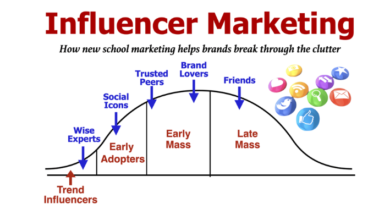Mastering Email Marketing: A Guide to Boost Your Digital Communication Strategy
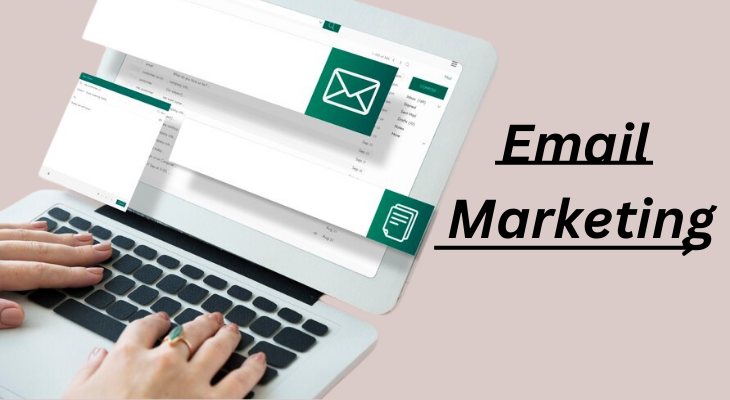
Hey there, savvy marketers! In the fast-paced world of digital communication, Email Marketing continues to stand tall as a powerhouse. Are you wondering if it’s still relevant? Let’s address that question and dive deep into the fundamentals, advantages, and disadvantages of Email Marketing .Hold on tight, though, because we’re not going to stop there. We’ll also explore the best strategies, automation tips, and the different types of email campaigns. Ready to level up your email game? Let’s get started!
Table of Contents
ToggleFundamentals of Email Marketing
Building a solid foundation is crucial. Start by curating targeted subscriber lists. No more spray-and-pray – we’re talking about crafting lists that make your campaigns sing. Manage and segment subscribers to tailor your content precisely to their needs. Engaging copywriting and eye-catching visuals are your secret sauce for creating compelling content. And don’t forget about responsive templates and A/B testing for that perfect layout. It’s all about nailing those basics!
4 types of email marketing
1.Transactional Emails:
Definition: Transactional emails are automated messages triggered by specific user actions. These emails provide information related to a transaction or interaction, often confirming a user’s action.
Examples:
- Order confirmations
- Shipping notifications
- Password reset emails
2.Promotional Emails:
Definition: Promotional emails are designed to showcase products, services, or special offers to encourage recipients to make a purchase or take advantage of a limited-time deal.
Examples:
- Product promotions
- Flash sales announcements
- Exclusive discounts
3.Relational Emails:
Definition: Relational emails focus on building and maintaining relationships with your audience. These messages aim to engage and nurture subscribers over time, fostering a sense of connection.
Examples:
- Welcome emails
- Educational newsletters
- Customer loyalty programs
4.Automated Email Sequences:
Definition: Automated email sequences are a series of emails sent based on predefined triggers or a set schedule. These sequences guide subscribers through a journey, providing relevant content and nudging them towards a specific goal.
Examples:
- Onboarding sequences
- Lead nurturing campaigns
- Abandoned cart reminders
Best Email Marketing Strategies
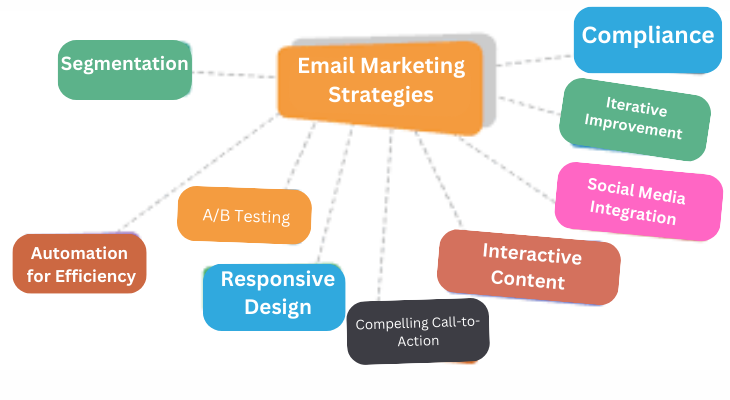
1.Segmentation and Personalization:
The era of one-size-fits-all emails is long gone. Segment your audience based on demographics, behaviors, or preferences, and tailor your content accordingly. Implement personalization by dynamically adapting your messages, from subject lines to content, creating a more individualized experience for each recipient.
2.Lifecycle Email Marketing:
Engage your audience throughout their journey with lifecycle email marketing. From welcome emails for new subscribers to re-engagement campaigns for dormant ones, understanding and addressing your audience’s needs at each stage fosters lasting relationships and customer loyalty.
3.Automation for Efficiency:
Embrace automation to streamline your processes and deliver timely, targeted messages. Set up automated sequences for onboarding, lead nurturing, and customer follow-ups. Automation not only saves time but ensures consistency and relevance in your communication.
4.Responsive Design for Mobile Users:
With a significant portion of users accessing emails on mobile devices, responsive design is non-negotiable. Craft templates that adapt seamlessly to various screen sizes, ensuring an optimal viewing experience for your audience and maximizing engagement.
5.A/B Testing for Optimization:
Refine your campaigns through A/B testing. Experiment with different elements such as subject lines, content variations, or CTAs to identify what resonates best with your audience. Continual testing and optimization enhance the effectiveness of your email marketing efforts.
6. Compelling Call-to-Action (CTA):
Each email you send should point readers in the direction of a particular action. Craft clear and compelling calls-to-action that prompt subscribers to click, make a purchase, sign up, or engage in the desired way. A well-designed CTA is pivotal for driving conversions.
7.Interactive Content to Enhance Engagement:
Break the monotony with interactive content. Incorporate elements like quizzes, polls, or clickable images to encourage engagement and participation. Interactive emails not only capture attention but also provide valuable insights into your audience’s preferences.
8.Social Media Integration:
Leverage the power of social media by integrating it into your email strategy. Encourage social sharing, incorporate social media buttons, and showcase user-generated content. This integration creates a cohesive brand experience across multiple channels.
9.Data Analysis and Iterative Improvement:
Examine key performance indicators (KPIs) on a regular basis, including conversion, click-through, and open rates.Use these insights to iteratively improve your strategies. Data-driven decision-making is essential for staying agile and responsive to your audience’s evolving preferences.
10. Compliance with Email Marketing Regulations:
Ensure your campaigns comply with email marketing regulations such as CAN-SPAM or GDPR. Respect subscriber preferences, provide clear opt-out options, and stay informed about any legal updates to maintain a positive sender reputation.
Advantages of Email Marketing
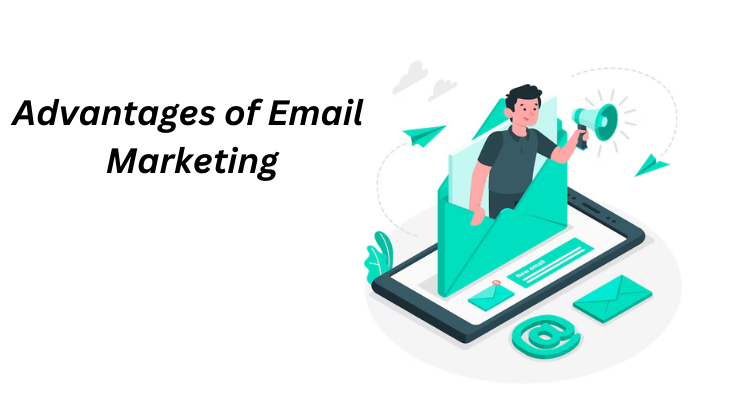
- Direct Communication Channel: One of the primary advantages of Email Marketing is its ability to establish a direct line of communication with your audience. Unlike social media platforms or search engine algorithms, emails allow you to connect with your subscribers on a personal level. It’s like knocking on their digital door and having a one-on-one conversation.
- Personalized Interaction: Emails provide a unique opportunity for personalized interaction. With the ability to segment your subscriber lists based on preferences, behavior, or demographics, you can tailor your messages to specific audience segments. Personalization fosters a sense of connection, making your audience more receptive to your content.
- Real-time Engagement:Emails offer real-time engagement, allowing you to deliver timely messages and updates. Whether it’s a flash sale, a product launch, or breaking news, email campaigns enable you to reach your audience instantly. Harnessing the power of real-time communication keeps your brand top of mind when it matters most.
- Cost-Effectiveness: In the realm of marketing, efficiency often goes hand in hand with cost-effectiveness. Compared to traditional advertising channels, Email Marketing is remarkably budget-friendly. No need for printing, postage, or airtime costs – it’s all about crafting compelling content and hitting ‘send.’
- Measurable Results:Email Marketing provides robust analytics and metrics to gauge the performance of your campaigns. Track open rates, click-through rates, and conversion rates to measure the effectiveness of your messages. With these insights, you can fine-tune your strategies, optimizing for better results with each campaign.
Disadvantages of Email Marketing
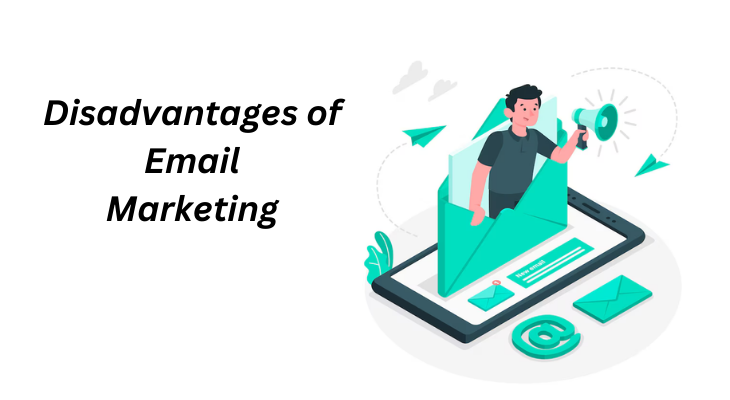
- Potential for Spam:One of the foremost challenges in Email Marketing is the constant battle against spam. With inboxes inundated with promotional messages, there’s a risk that your carefully crafted emails might be misinterpreted as spam. This not only affects your deliverability but also damages your brand’s reputation.
- Deliverability Issues: Even with opt-in strategies and targeted campaigns, emails may still face deliverability challenges. Factors like email server issues, outdated subscriber lists, or stringent spam filters can hinder your messages from reaching the intended audience.
- Content Filtering Challenges: Email clients and ISPs employ sophisticated algorithms to filter out unwanted content. This means that even relevant and valuable messages can end up in the dreaded spam folder, significantly reducing the chances of engagement.
- Over-reliance on Email: Relying solely on Email Marketing may lead to missed opportunities. Not all audiences prefer communication through this channel, and diversifying your marketing strategy ensures broader reach and engagement.
How to Automate Your Email Marketing
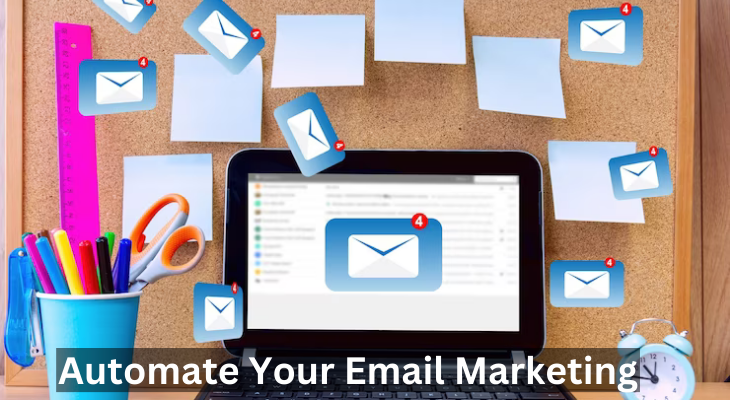
- Understanding the Importance of Automation: Before diving into the how-to, let’s explore why automation is crucial. Automation empowers you to deliver timely, targeted messages without the constant manual effort. It enhances efficiency, ensures consistency, and allows for personalized interactions at scale.
- Setting Objectives for Automation: Define your goals. Whether it’s increasing engagement, nurturing leads, or boosting sales, having clear objectives guides your automation strategy. Identify key touchpoints in your customer journey where automation can make the most significant impact.
- Selecting the Right Automation Tools: Investing in the right tools is paramount. There are many systems for email marketing automation out there, and they all have different characteristics. Consider factors like ease of use, integration capabilities, and scalability when choosing the tool that aligns with your business needs.
- Enhancing Efficiency through Automation: Now, let’s get down to the nitty-gritty. Here’s a step-by-step guide to implementing automation in your Email Marketing strategy:
- Segment Your Audience: – Use subscriber data to create segments based on demographics, behaviors, or engagement levels.
- Create Engaging Drip Campaigns:– Create drip campaigns that are automated and send out a series of focused messages over time.
- Personalize Content Dynamically: – Utilize dynamic content that adapts based on subscriber preferences or behaviors.
- Implement Trigger-Based Automation: – Set up triggers based on user actions, such as clicks, opens, or website visits.
- Testing and Optimization: The beauty of automation lies in its adaptability. Regularly test different elements of your automated campaigns, from subject lines to content, and use the insights gained to optimize for better results.
- Monitoring and Analyzing Performance:Keep a close eye on your automation performance metrics.Monitor the rates of click-through, conversion, and open. Utilize this information to strengthen your tactics and guarantee ongoing progress.
Is Email Marketing Outdated?
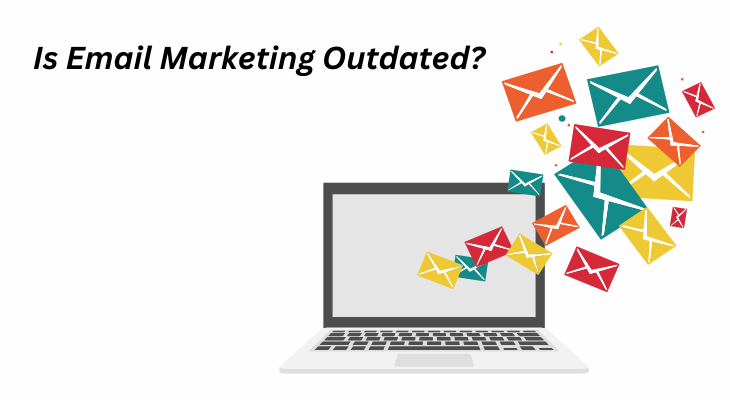
Far from being outdated, Email Marketing remains a dynamic and pivotal component of digital communication strategies. Despite the proliferation of various communication channels and social media platforms, emails continue to provide a direct and personalized way to engage with audiences. The adaptability of Email Marketing is evident in its evolution to incorporate advanced personalization, automation, and segmentation techniques. With the ability to deliver targeted content, nurture leads, and build lasting relationships, emails remain an integral part of successful marketing campaigns. The key lies in leveraging contemporary strategies, such as mobile optimization, interactive content, and data-driven decision-making, to ensure Email Marketing remains a vibrant and effective tool in the ever-changing landscape of digital marketing. Far from being outdated, Email Marketing evolves and adapts, proving its resilience and effectiveness in reaching and resonating with diverse audiences.
Steps of Email Marketing
- Define Your Objectives: Before diving into the details, establish clear goals for your Email Marketing efforts. Whether it’s driving sales, increasing brand awareness, or nurturing leads, having defined objectives will shape your entire strategy.
- Build a Quality Subscriber List:Start by building a subscriber list composed of individuals genuinely interested in your content or offerings. Leverage various channels to encourage sign-ups, ensuring transparency about the type of content subscribers can expect.
- Segment Your Audience: Not all subscribers are the same.Divide up your audience into segments according to their behavior, demographics, or past purchases. This enables you to tailor your messages, delivering content that resonates with specific groups.
- Craft Compelling Content: Content is the lifeblood of any email campaign that succeeds. Craft compelling copy, use engaging visuals, and ensure that your message aligns with the needs and preferences of your segmented audience.
- Design Engaging Templates: When it comes to drawing in your audience, design is essential. Utilize responsive templates that look great on various devices, and consider A/B testing different designs to optimize for user engagement.
- Implement Personalization:Personalization adds a human touch to your emails. Incorporate subscriber names, recommend personalized content, and use dynamic content to create a more tailored experience for your audience.
- Set Up Automation: Automate certain aspects of your campaigns to save time and deliver timely messages. Set up automated sequences for onboarding, lead nurturing, or even abandoned cart reminders, ensuring consistent and relevant communication.
- Include Clear Call-to-Action (CTA):Every email should guide the recipient toward a specific action. Include a clear and compelling call-to-action (CTA) that prompts your audience to click, purchase, sign up, or engage in the desired way.
- Test and Optimize:Regularly test different elements of your emails, such as subject lines, content, images, and CTAs. Analyze the results, learn from what works and what doesn’t, and optimize your campaigns accordingly.
- Deploy and Monitor: Once your email is ready, deploy it to your segmented audience.Keep an eye on important metrics like conversions, click-through rates, and open rates. Use these metrics to evaluate your campaign’s success and gather insights for future improvements.
- Maintain Compliance: Ensure your email campaigns comply with relevant regulations such as CAN-SPAM or GDPR. Include clear opt-out options, respect subscriber preferences, and stay informed about any legal updates in the email marketing landscape.
- Review and Iterate: After each campaign, conduct a thorough review. Analyze performance metrics, gather feedback, and iterate on your strategy. Continuous improvement is key to a successful and evolving Email Marketing strategy.
Conclusion
Mastering the art of Email Marketing requires a strategic and iterative approach. By defining clear objectives, building a quality subscriber list, and segmenting your audience, you set the foundation for targeted and impactful campaigns. Crafting compelling content, designing engaging templates, and implementing personalization enhance the overall user experience. Automation streamlines your efforts, allowing for timely and consistent communication. Clear calls-to-action, continuous testing, and optimization ensure your messages resonate with your audience. Deploying campaigns, monitoring key metrics, and maintaining compliance contribute to the success of your endeavors.
FAQs in Email Marketing
Why is Email Marketing important for my business?
One direct and individualized way to communicate with your audience is through email marketing.It is cost-effective, measurable, and facilitates real-time engagement, making it an essential tool for building relationships and driving business growth.
How can I build an effective subscriber list for my Email Marketing campaigns?
Building an effective subscriber list involves strategies such as creating engaging opt-in forms, offering incentives, and ensuring transparency about the type of content subscribers will receive. Quality over quantity is key, ensuring your list comprises engaged and interested individuals.
What are some best practices for crafting engaging email content?
Engaging email content is built on compelling copywriting, visually appealing design, and relevance to your audience. Utilize segmentation to tailor content, include a clear call-to-action, and optimize for mobile responsiveness to enhance engagement.
How do I prevent my emails from being marked as spam?
To avoid the spam folder, focus on obtaining explicit consent from subscribers, use a recognizable sender name, provide clear opt-out options, and avoid misleading subject lines. Regularly clean your subscriber list and adhere to email marketing regulations to maintain a positive sender reputation.
Can I use emojis in my email subject lines?
Yes, incorporating emojis can add a touch of personality and catch the reader’s attention. However, use them sparingly and ensure they align with your brand and the tone of your message.
What is the significance of A/B testing in Email Marketing?
A/B testing, or split testing, allows you to compare two versions of an email to determine which performs better. It helps optimize elements such as subject lines, copy, images, and calls-to-action, providing valuable insights for refining your future campaigns.
How can I measure the success of my Email Marketing campaigns?
Measure success through key performance indicators (KPIs) like open rates, click-through rates, conversion rates, and overall return on investment (ROI). Analyzing these metrics provides actionable insights to enhance future campaigns.
How often should I send emails to my subscribers?
The frequency of email campaigns depends on your audience and the nature of your content. Strive for a balance between staying top-of-mind and avoiding inbox fatigue. Try out various frequencies to see which ones your target audience responds to the best.
What are the benefits of personalization in Email Marketing?
Personalization enhances the relevance of your emails, increasing engagement and conversions. By utilizing subscriber data to tailor content, recommendations, and even subject lines, you create a more meaningful connection with your audience.
How can I stay compliant with email marketing regulations?
Stay compliant by obtaining explicit consent, including clear opt-out options, providing identifiable sender information, and adhering to regulations like CAN-SPAM and GDPR. Regularly review and update your practices to align with evolving legal standards.




